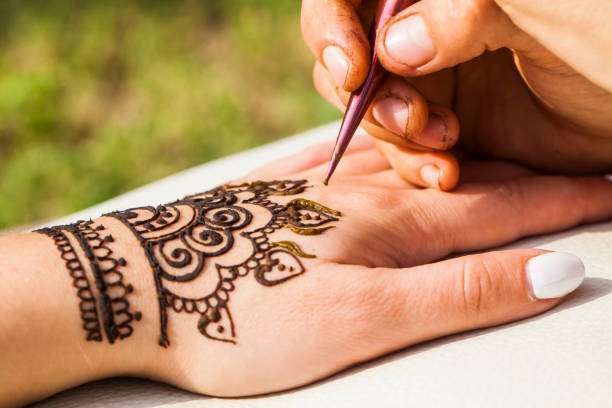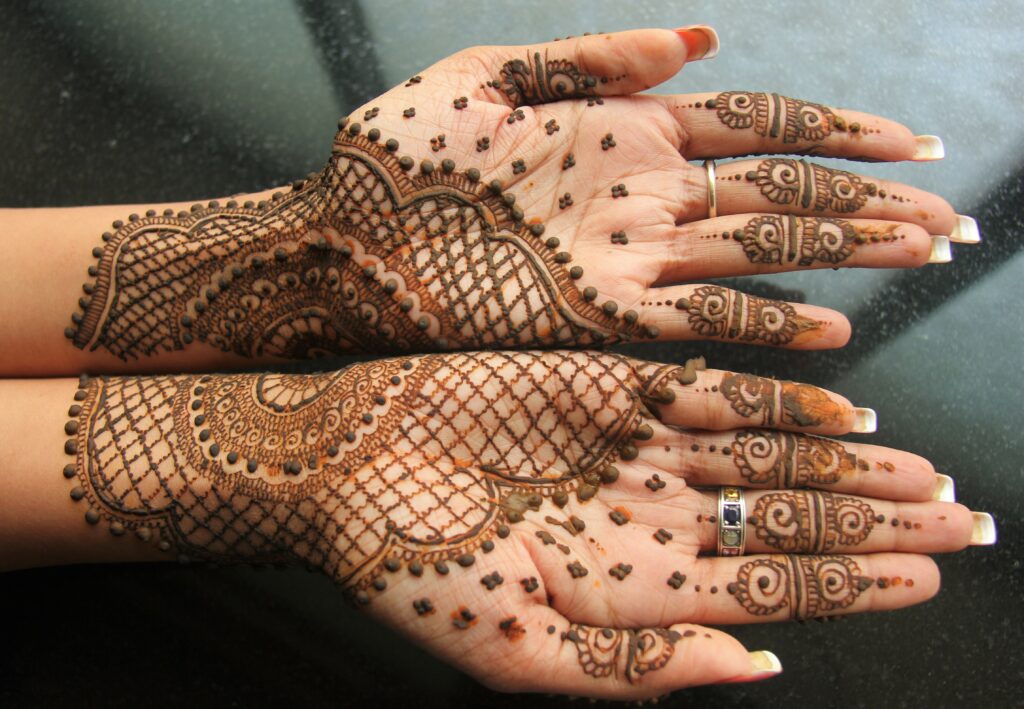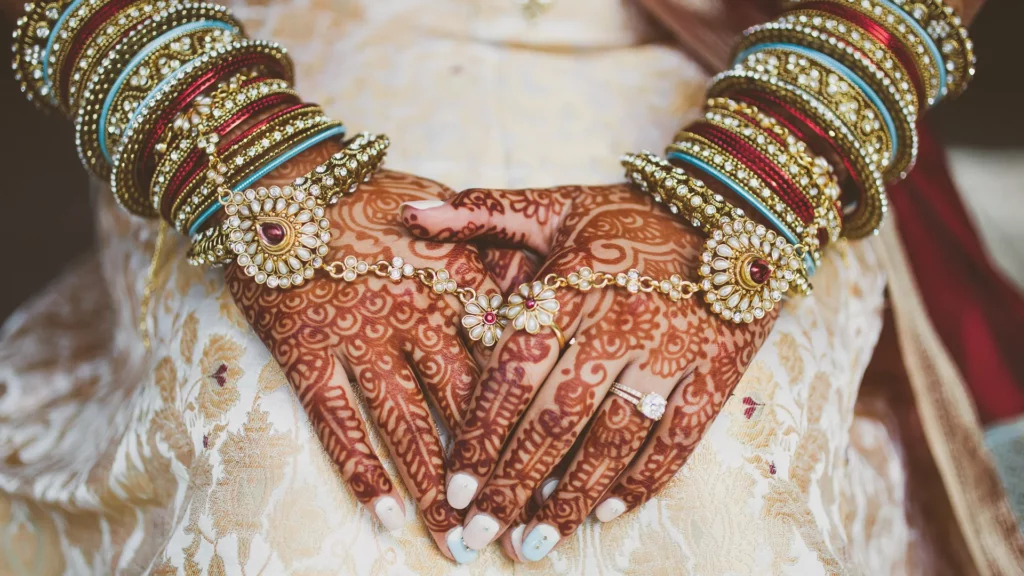Mehendi, also known as henna, is a form of body art that has been practiced for centuries in various cultures. It involves the application of a paste made from the leaves of the henna plant to create intricate and temporary designs on the skin. This art form has deep cultural and social significance in many parts of the world.

Origins of Mehendi
Mehendi’s roots are unknown, however it is thought to have started around 5,000 years ago in North Africa or the Middle East. Ancient Egyptians, Greeks, and Romans utilized mehendi for both cosmetic and therapeutic purposes. The Sanskrit word “mendhika,” which meaning “red dye,” is where the name “mehendi” originates. Henna plant leaves that have been dried and powdered into a powder are used to make mehendi. To create a paste, the powder is combined with water or another liquid. Mehendi may be used on different body areas besides the hands, feet, and arms where it is generally administered. Mehendi artists employ a range of methods to produce complicated and stunning patterns.


Mehendi Process
The mehendi process is relatively simple, but it takes time and patience to create intricate and beautiful designs.
Here is a step-by-step guide to the mehendi process:
- Prepare the skin. The skin should be clean and dry before applying You can exfoliate the skin gently to remove any dead skin cells.
- Apply the mehendi paste. Use a paint brush or a cone to apply the paste to the skin. Be sure to apply the paste evenly and in a smooth layer.
- Let the dry. The will need to dry for several hours, typically 2-4 hours. You can wrap your hands and feet in plastic wrap to help the mehendi dry.
- Remove the paste. Once the has dried, you can remove it by gently scraping it off with your fingers. You can also use a washcloth and warm water to remove the paste.
- Seal the stain. To help the stain last longer, you can seal it with a mixture of lemon juice and sugar. Apply the mixture to the mehendi stain and let it dry for a few minutes.
Cultural Significance
Mehendi is a beautiful and versatile form of body art with a deep cultural significance in many parts of the world. It is often used in weddings and other celebrations, and it is seen as a symbol of beauty, fertility, and good luck.
For example, in India, brides traditionally have applied to their hands and feet before their wedding day. The is said to bring good luck to the bride and to symbolize her love and devotion to her husband. is also used in many Hindu and Muslim festivals, such as Karwa Chauth, when Hindu women fast for the entire day and then apply to their hands and feet in the evening. The is said to bring good luck to their husbands and to symbolize their love and devotion.
In North Africa, is often used in Berber and Arab wedding ceremonies. The is said to bring good luck to the bride and to protect her from evil spirits. is also used in many other cultures around the world, including Southeast Asia, the Middle East, and Africa, where it is often used in weddings and other celebrations and is seen as a symbol of beauty, fertility, and good luck.
In addition to its cultural significance, is also used for a variety of medicinal purposes. The henna plant has natural cooling properties, so it is often used to treat skin conditions such as sunburn and eczema. Henna is also used to treat headaches, stomachaches, and other ailments.
Modern Usage
- Fashion: Mehendi is often used as a fashion accessory. It can be worn on the hands, feet, arms, legs, and even the back. artists can create intricate and beautiful designs that are tailored to the individual’s style.
- Self-expression:can also be used as a form of self-expression. People may choose to get designs that are meaningful to them, such as their favorite quotes, symbols, or religious texts.
- Weddings: Mehendi is a traditional part of many weddings in India and other parts of the world. Brides and grooms often have applied to their hands and feet before the wedding ceremony. is said to bring good luck and happiness to the couple.
- Festivals: Mehendi is also popular during festivals, such as Diwali, Holi, and Eid. People may choose to get mehendi designs that are specific to the festival they are celebrating.
- Temporary tattoos: Mehendi can also be used to create temporary tattoos. This is a popular option for people who want to get a tattoo but are not sure if they want to commit to a permanent design
Benefits of Mehendi?
- Natural hair dye: It is a natural hair dye that can be used to color hair without the use of harsh chemicals. It can also help to strengthen the hair and reduce hair loss.
- Cooling effect: It has a cooling effect on the skin, which can help to relieve itching, sunburn, and other skin conditions.
- Antiseptic properties: It has antiseptic properties that can help to heal wounds and prevent infections.
- Anti-inflammatory properties:Ithas anti-inflammatory properties that can help to reduce inflammation and pain.
- Astringent properties: It has astringent properties that can help to tighten the skin and reduce pores.
- Antioxidant properties: It has antioxidant properties that can help to protect the skin from damage caused by free radicals.
- Conditioner: It can be used as a natural conditioner for the hair and skin. It can help to soften and smooth the hair and skin, and reduce frizz.
- Dandruff treatment: Mehendi can be used to treat dandruff and other scalp conditions. It has antifungal and antibacterial properties that can help to kill the fungus and bacteria that cause dandruff.
- Headache relief: Mehendi can be used to relieve headaches. It has cooling and anti-inflammatory properties that can help to reduce pain and inflammation.
Conclusion
Mehendi is a beautiful and versatile form of body art with a deep cultural significance in many parts of the world. It is often used in weddings and other celebrations, and it is seen as a symbol of beauty, fertility, and good luck.
Mehendi is also used for a variety of medicinal purposes. The henna plant has natural cooling properties, so it is often used to treat skin conditions such as sunburn and eczema. Henna is also used to treat headaches, stomachaches, and other ailments.
FAQs
The CMA exam is a professional certification exam for management accountants. It is administered by the Institute of Management Accountants (IMA).
- It is a safe and natural way to decorate the body.
- It can be used to create a variety of beautiful and intricate designs.
- It can be used to treat certain skin conditions, such as sunburn and eczema.
- It has a cooling effect on the skin, which can be helpful in hot weather.
- It is a fun and creative way to express yoursel
Mehendi typically lasts for 5-7 days, but it can last up to 2 weeks with proper care. To keep your mehendi looking its best, avoid washing it with soap and water for the first 24 hours. After that, you can wash it gently with soap and water. You can also apply a thin layer of oil to your mehendi to help it last longer.
- Make sure your skin is clean and dry before applying mehendi.
- Apply the mehendi paste using a cone or a brush.
- Allow the mehendi paste to dry completely before washing it off.
- Avoid washing your mehendi with soap and water for the first 24 hours.
- Apply a thin layer of oil to your mehendi to help it last longer.






